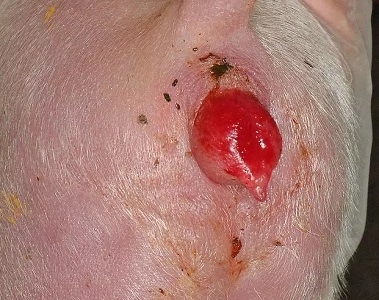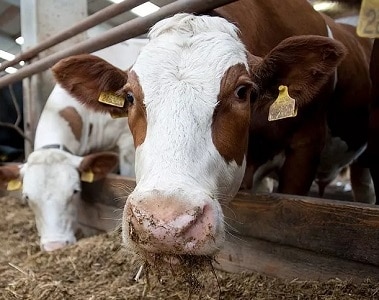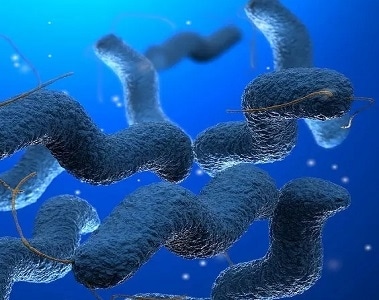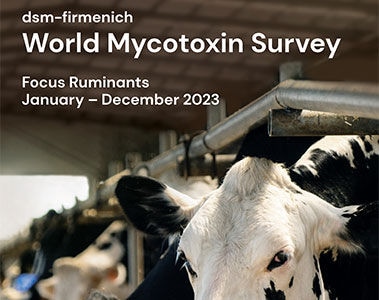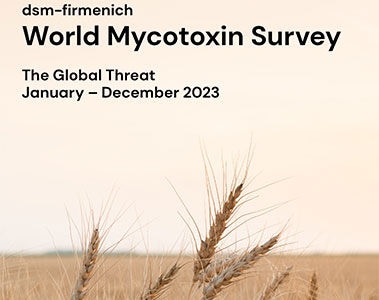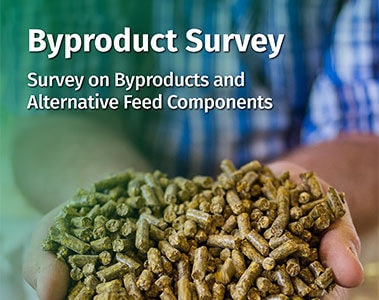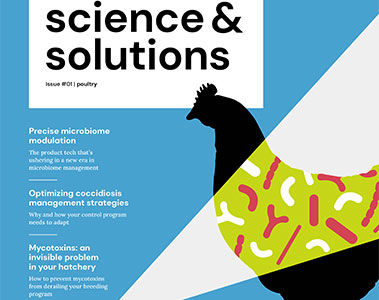| Metabolite | Description |
| Deoxynivalenol | Deoxynivalenol induces emesis and feed refusal resulting in reduced weight gain. Other effects include immunotoxicity, hematotoxicity and myelotoxicity, as well as reproductive toxicity. It furthermore causes intestinal lesions and compromises the intestinal barrier function. DON enhance signs of PRRSV infection and caused vaccination failure in a vaccination-challenge trial. |
| Beauvericin | Beauvericin is toxic to different mammalian cell lines in vitro. According to published studies, acute exposure to beauvericin was not toxic to animals. However, the effect of chronic exposure is currently unknown. According to the results of in vitro studies, enniatins may affect the immune system and the bioavailability of pharmaceuticals. Enniatins were shown to accumulate in the eggs of laying hens, but detected levels were likely no cause for concern.Beauvericin exhibits cytotoxic effects on intestinal procine epithelial cells (IPEC-J2) |
| Enniatin B | Enniatins are toxic to different mammalian cell lines in vitro. The effect of chronic exposure is currently unknown. According to the results of in vitro studies, enniatins may affect the immune system and the bioavailability of pharmaceuticals. Enniatins were shown to accumulate in the eggs of laying hens, but detected levels were likely no cause for concern. Ennitatins exhibit cytotoxic effects on intestinal porcine epithelial cells (IPEC-J2). |
| Enniatin B1 | Enniatins are toxic to different mammalian cell lines in vitro. The effect of chronic exposure is currently unknown. According to the results of in vitro studies, enniatins may affect the immune system and the bioavailability of pharmaceuticals. Enniatins were shown to accumulate in the eggs of laying hens, but detected levels were likely no cause for concern. Ennitatins exhibit cytotoxic effects on intestinal porcine epithelial cells (IPEC-J2). |
| Zearalenone | Zearalenone is an estrogenic toxin, i.e. it acts like the endogenous steroidal sex hormone estradiol thereby compromising the fertility and reproduction of animals. Furthermore, ZEN has been shown to be hepatotoxic, hematotoxic, immunotoxic and genotoxic. |
| Fumonisin B1 | Fumonisins are hepatotoxic and nephrotoxic. High fumonisin doses cause the species specific fatal diseases porcine pulmonary edema in pigs and equine leukoencephalomalacia in horses . Fumonisin B1 has been classified as a group 2B carcinogen.
Fumonisins were shown to be immunotoxic and to compromise gut health. They furthermore exert reproductive toxicity. Within the group of Fumonisins, Fumonisin B1 is the most toxic. |
| Fumonisin B2 | Fumonisins are hepatotoxic and nephrotoxic. High fumonisin doses cause the species specific fatal diseases porcine pulmonary edema in pigs and equine leukoencephalomalacia in horses . Fumonisins were shown to be immunotoxic and to compromise gut health. They furthermore exert reproductive toxicity. |
| Moniliformin | Moniliformin is shown to be toxic to rodents and poultry. Toxic effects include damage to the heart muscle, respiratory distress, decreased feed intake and body weight gain and impaired immune function. |
| Enniatin A1 | Enniatins are toxic to different mammalian cell lines in vitro. The effect of chronic exposure is currently unknown. According to the results of in vitro studies, enniatins may affect the immune system and the bioavailability of pharmaceuticals. Enniatins were shown to accumulate in the eggs of laying hens, but detected levels were likely no cause for concern. Ennitatins exhibit cytotoxic effects on intestinal porcine epithelial cells (IPEC-J2). |
| Fumonisin B3 | Fumonisins are hepatotoxic and nephrotoxic. High fumonisin doses cause the species specific fatal diseases porcine pulmonary edema in pigs and equine leukoencephalomalacia in horses. Fumonisins were shown to be immunotoxic and to compromise gut health. They furthermore exert reproductive toxicity. |
| Alternariol | Alternariol is cytotoxic, genotoxic and mutagenic to mammalian cell lines in vitro. Furthermore, negative effects of alternariol on the reproductive and immune system have been suggested by in vitro results. |
| Deoxynivalenol-3-Glucoside | Deoxynivalenol-3-glucoside is a plant metabolite of deoxynivalenol. Deoxynivalenol-3-glucoside is less toxic than deoxynivalenol, but it is converted back to deoxynivalenol in the gastrointestinal tract of mammals. In pigs and in rats, deoxynivalenol-3-glucoside was shown to be converted to deoxynivalenol in the gastrointestinal tract and deoxynivalenol was adsorbed from the gastrointestinal tract. |
| Enniatin A | Enniatins are toxic to different mammalian cell lines in vitro. The effect of chronic exposure is currently unknown. According to the results of in vitro studies, enniatins may affect the immune system and the bioavailability of pharmaceuticals. Enniatins were shown to accumulate in the eggs of laying hens, but detected levels were likely no cause for concern. Ennitatins exhibit cytotoxic effects on intestinal porcine epithelial cells (IPEC-J2). |
| Nivalenol | Nivalenol is a type B trichothecene. It induces emesis and feed refusal resulting in reduced weight gain. Other effects include immunotoxicity, hematotoxicity, reproductive toxicity and pathological alterations in the kidneys and gastrointestinal tract. |
| Aflatoxin B1 | Aflatoxins are carcinogenic mycotoxins. They have been classified as group 1 carcinogens (carcinogenic to humans) by the International Agency for Research on Cancer. The primary target organ of aflatoxins is the liver. Furthermore, aflatoxins cause immunotoxicity, reproductive toxicity, gastrointestinal toxicity, reduced growth and decreased milk and egg production. |
| HT-2 Toxin | HT-2 toxin is a type A trichothecene and a metabolite of T-2 toxin. HT-2 toxin showed a high acute toxicity in mice and chickens with LD50 values in the same dose range as reported for T-2 toxin. HT-2 toxin was shown to induce feed refusal in mice. Haematotoxic, immunotoxic and cytotoxic effects of HT-2 toxin were observed in vitro. |
| 15-Acetyl-Deoxynivalenol | 15-Acetyldeoxynivalenol is a metabolite of the mycotoxin Deoxynivalenol. It can be converted to Deoxynivalenol in the intestinal tract. 15-Acetyldeoxynivalenol was shown to induce emesis and feed refusal. It was furthermore shown to be cytotoxic, to disrupt the barrier integrity of epithelial cells and to exert immunosuppressive effects on human peripheral blood mononuclear cells. Depending on test system, 15-Acetyldeoxynivalenol is as toxic or even more toxic as Deoxynivalenol. |
| Sterigmatocystin | Sterigmatocystin is a precursor of aflatoxins and structurally similar to aflatoxin B1. Sterigmatocystin causes similar effects as aflatoxin B1 in animals, albeit with lower acute toxicity. In dairy cows, sterigmatocystin caused bloody diarrhea and reduced milk production. In pigs, sterigmatocystin caused decreased feed intake, incidental diarrhea and necrotic alterations of the liver tissue. Hepatotoxic and nephrotoxic effects of sterigmatocystin were observed in poultry. Furthermore, sterigmatocystin decreased body weight gain in different fish species. |
| T-2 Toxin | T-2 toxin is a type A trichothecene. It showed a high acute toxicity in mice and chickens. T-2 toxin was shown to reduce feed intake in different species including pigs, ducks and mice. Other effects observed in different animal species include immunotoxicity, hematotoxicity, reproductive toxicity and hepatotoxicty. |
| Ochratoxin A | Ochratoxin A is a nephrotoxic mycotoxin. It has been classified as a group 2B carcinogen (possibly carcinogenic to humans) by the International Agency for Research on Cancer. Furthermore, ochratoxin A causes immunotoxicity, developmental toxicity and hepatotoxicity. |
| alpha-Ergocryptine | Ergot alkaloids are known to affect the nervous system and to be vasoconstrictors. Symptoms of ergot alkaloid intoxication include tremors, vomiting and spontaneous abortion. |
| Mycophenolic Acid | Mycophenolic acid shows a low acute toxicity in animals, but may cause immunosuppression. |
| Ergocristine | Ergot alkaloids are known to affect the nervous system and to be vasoconstrictors. Symptoms of ergot alkaloid intoxication include tremors, vomiting and spontaneous abortion. |
| Ergotamine | Ergot alkaloids are known to affect the nervous system and to be vasoconstrictors. Symptoms of ergot alkaloid intoxication include tremors, vomiting and spontaneous abortion. |
| Aflatoxin B2 | Aflatoxins are carcinogenic mycotoxins. They have been classified as group 1 carcinogens (carcinogenic to humans) by the International Agency for Research on Cancer. The primary target organ of aflatoxins is the liver. Furthermore, aflatoxins cause immunotoxicity, reproductive toxicity, gastrointestinal toxicity, reduced growth and decreased milk and egg production. |

